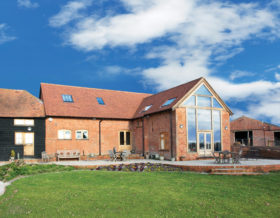
21st-22nd February 2026 - time to get your dream home started!
BOOK HERE
21st-22nd February 2026 - time to get your dream home started!
BOOK HEREOf all the rooms in the house, the kitchen needs to have the most flexible lighting scheme to reflect the wide range of functions it must fulfil.
Kitchen lighting needs to adapt from a bright, general light for the day, to a level that’s suitable for the children’s tea and homework at dusk, and intimate light for dining in the evening.
Overall, you need to have good general lighting, good task lighting and mood lighting.
The term general lighting refers to the overall illumination of a room, and it plays the role of daylight – this means it’s particularly important in north-facing kitchens or small rooms with poor natural light.
| Find the perfect finishing touches for your project at Build It Live. Watch live presentations on a variety of self build and renovation topics, browse thousands of products and get your specific questions answered.
Build It Live takes place three times a year in Kent, Malvern and Exeter. The next show will be on 21st and 22nd February 2026 in Maidstone, Kent. Claim a pair of free tickets today and start planning your visit. |
In a kitchen, general light should be as close to daylight as possible, so that you can tell if food is cooked properly, or if raw food is fresh. General light can include direct and indirect (reflected) light sources – for example, central pendant lights, ceiling-mounted fittings, wall lights, downlights, and uplights.
Read more: Kitchen Design & Costs
Recessed lights – such as the Double Trim with low glare AR70 Halospot lamps – placed at intervals in the ceiling are a good option, as they light the workspace with a bright light for day and can be dimmed for mood lighting at night.
A single, central pendant light – often the only source of general light in unmodernised kitchens – isn’t the best choice for general lighting as it tends to leave the corners of the room in shadow.
However, pendant lights do work well hung over a dining table for mood lighting, or if they’re used to highlight a specific kitchen feature.
Good task lighting in the kitchen is essential to help you with food preparation and cooking.
Any task lighting should be fairly bright and positioned so it doesn’t cast shadows over your working area.
Task lights include directional lights, such as downlights and spotlights – under-cupboard lighting, which casts a pool of light over the worksurface, is ideal.
Read more: How to Create an Automated Lighting Scheme
You can use a directional downlight, such as the Polestar, to great effect to bounce light off fitted cupboards, accentuating colour and creating the illusion of more space.
When you’re choosing general lighting for the kitchen, if you opt for designs that you can dim you’ll have mood lighting in an instant.
However, it’s also worth considering lights that pick out various kitchen features – then when you dim or turn off the general lighting, these lights will change the entire look of the kitchen.
For example, if you fit Sirolo lights to the plinth of a central island they’ll throw pools of light out over the floor. And if you fit light strips to the legs of kitchen units – for example Clickstrip – it’ll look as if your furniture is floating.
Highlighting shelves and cupboard doors will again help turn a daytime kitchen into a place to relax over dinner in the evening.
And lastly, experiment with coloured lighting – for example, an illuminated splashback that turns from one shade to another. But be careful – a colourful light that’s too bright will spoil the mood.
Top Tips
|
Read more: Lighting Scheme Guide With Cost Tables
As with all building products, prices vary enormously; the cost of different light fittings presented below are purely a guide.
Although many folks leave it to the electrician to supply these, if lighting is important to you then it’s better to visit suppliers and look into the options – much like you would with other elements, such as bathroom fittings.
It’s difficult to isolate the overall labour costs of having your artificial illumination installed as this will be carried out as part of the overall electrical installation at both the first and second fix stages.
However, lighting will represent about half of the electrician’s work in the house and it usually takes two weeks for first fix and another two for second and final commissioning.
Main image: This kitchen features a mix of lighting by John Cullen, including under- and over-cabinet spotlights for atmosphere

Comments are closed.